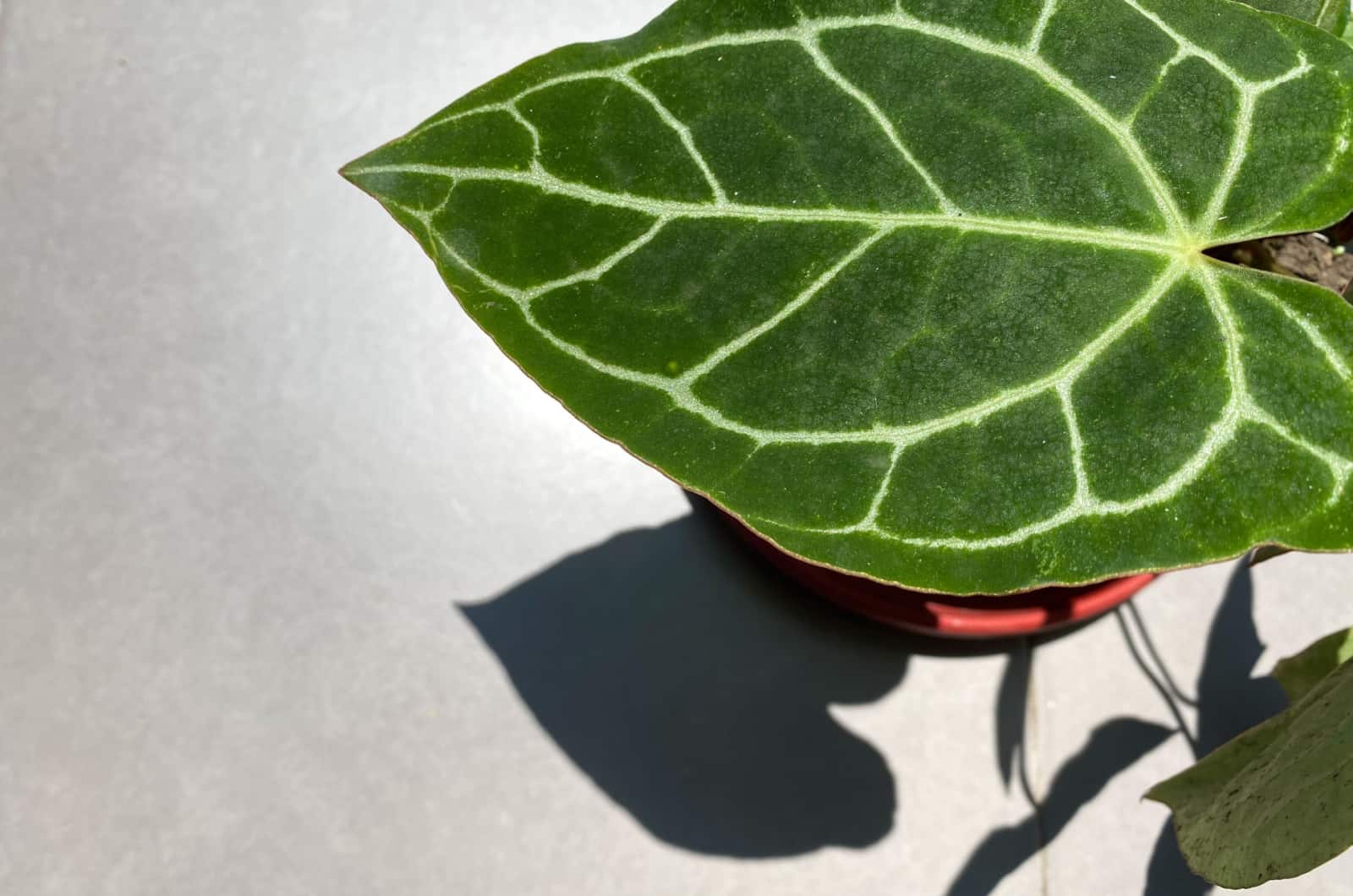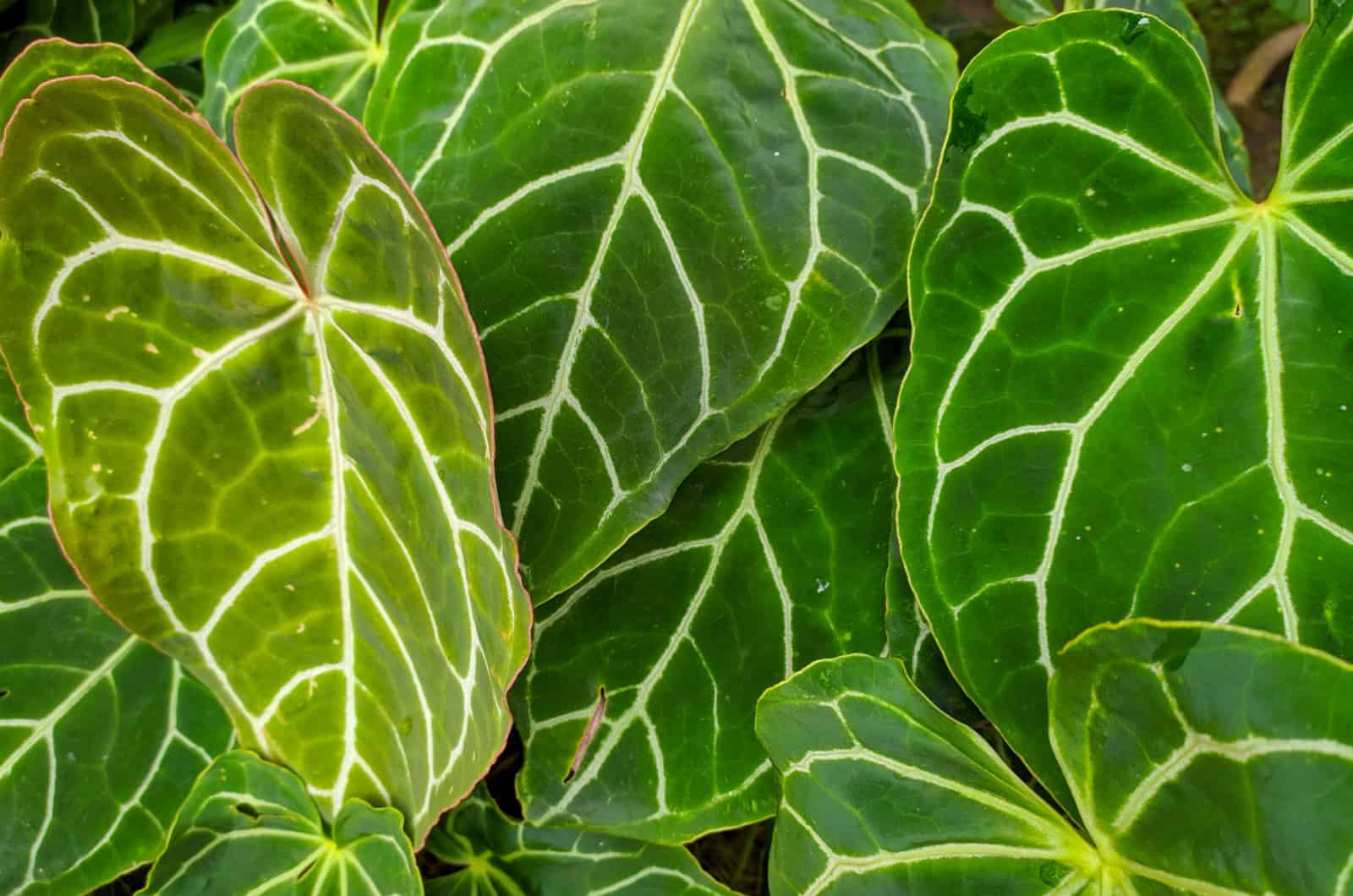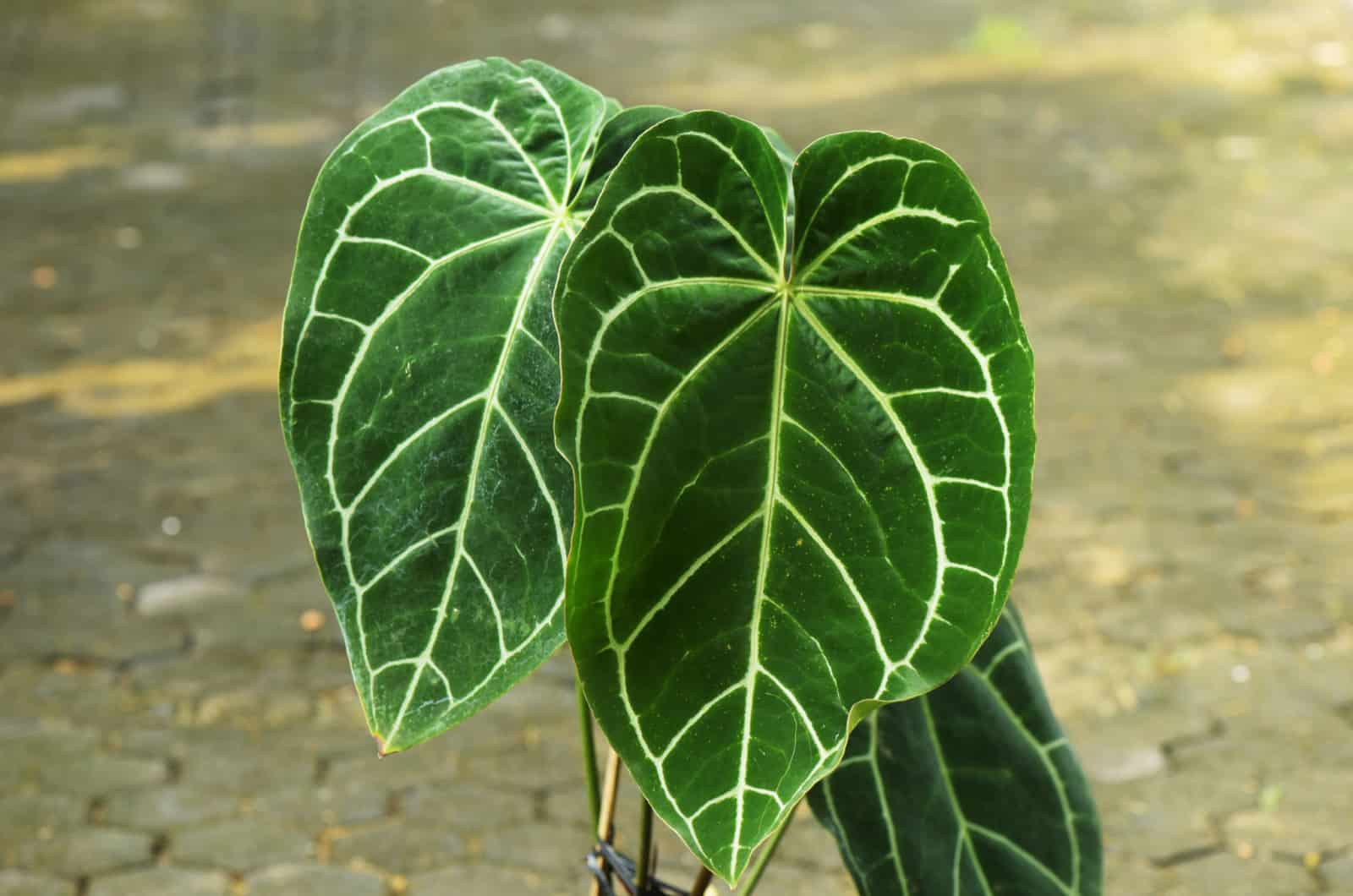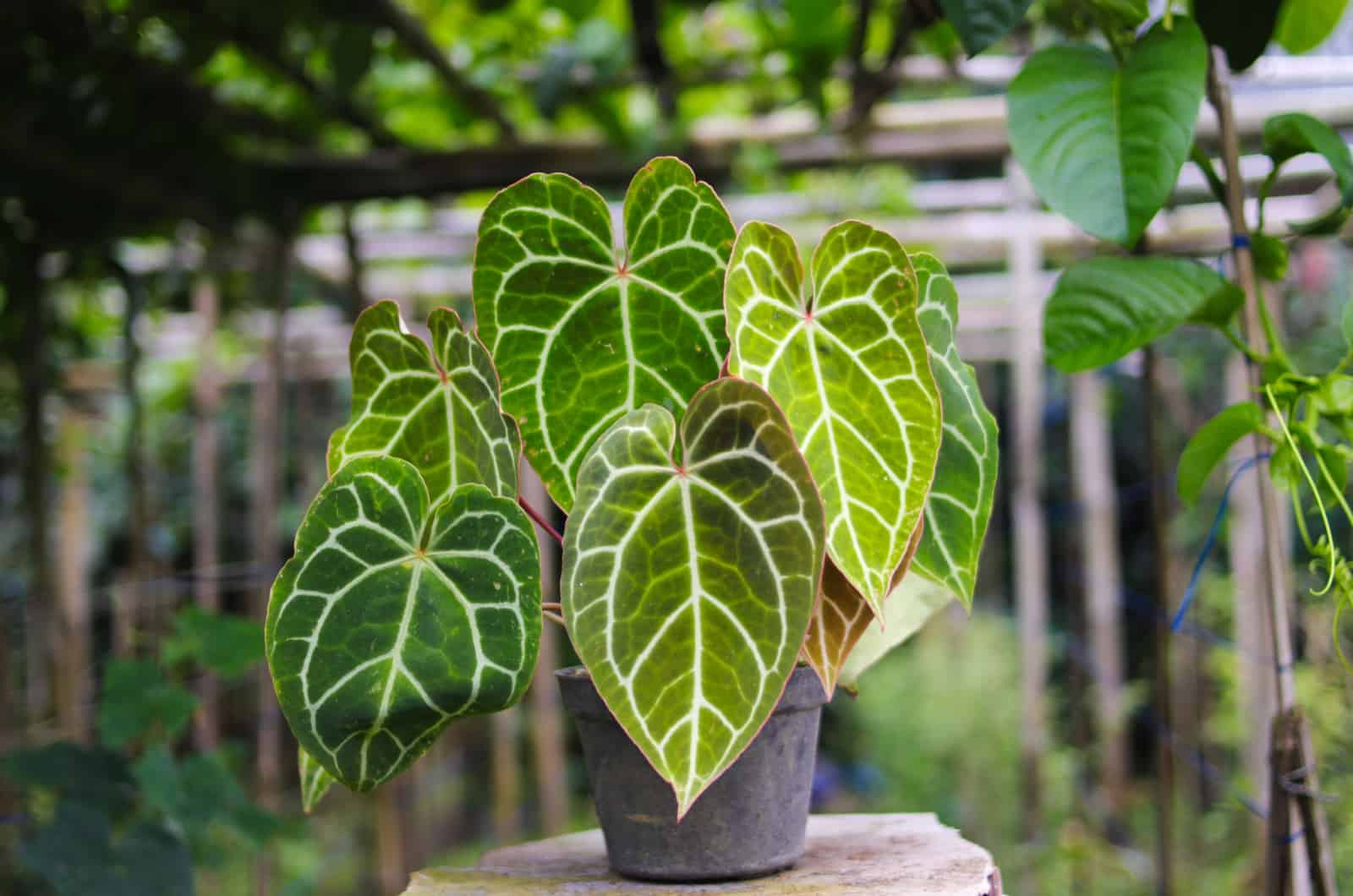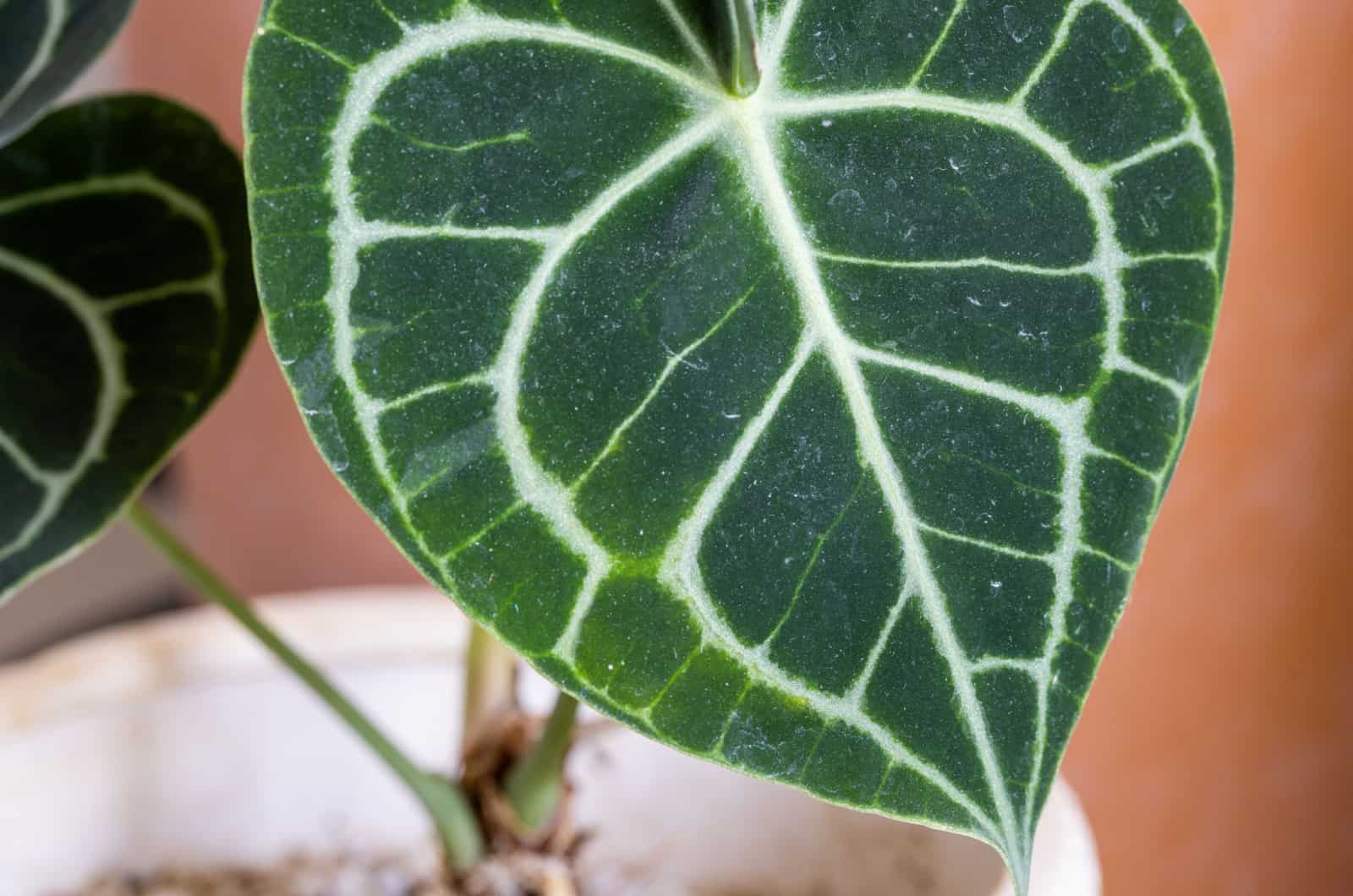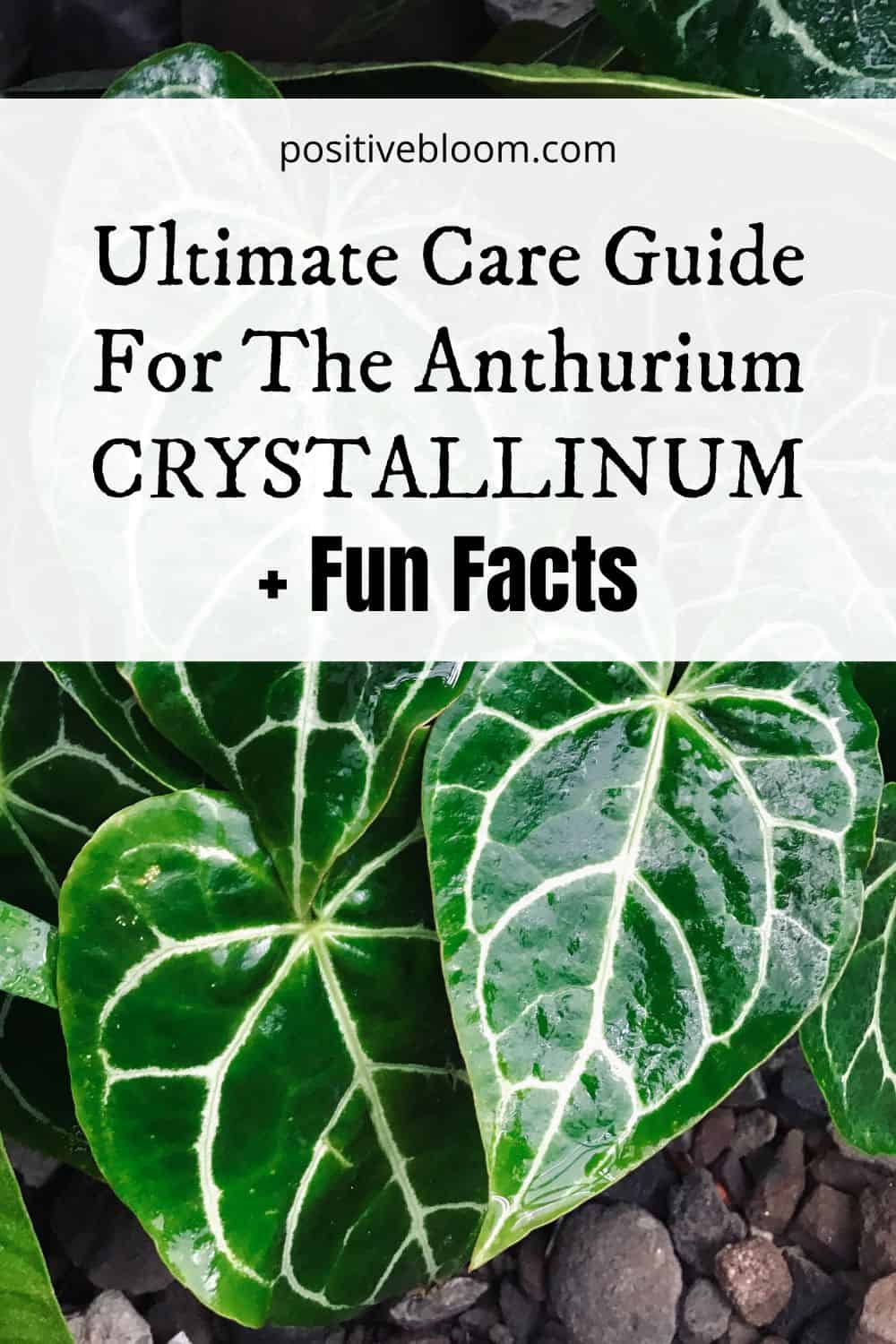The deep green foliage streaked with white veins of the Anthurium crystallinum is a sight no one can resist.
This plant does require some more attention than the others you might have, which means you’ll have to irrigate it more often and ensure the soil mix has excellent drainage, but still retains moisture, among other things.
There are other requirements you should meet in order to nurture a healthy plant, and we’ll discuss them in the article below.
You’ll also learn more about this plant’s history, origin, and appearance, and discover how it differs from some other anthuriums.
Let’s look into its specifics before going into more detail:
[table id=465 /]
Anthurium Crystallinum Care Guide
If you already have another anthurium in your home or have read everything you can about Anthurium chamberlainii plant care, you can apply that knowledge to the crystal anthurium as well.
It is a plant native to rainforests, so all you’ve got to do is mirror its natural environment, and your houseplant will thrive. Indirect light, moist and well-draining soil, and high humidity levels are some of the requirements you’ll have to meet.
But don’t worry because you can easily get these things done in no time!
Light Requirements
The A. crystallinum requires bright light for optimal growth, so you should grow it near east or south-facing windows where they can get the best lighting.
However, if you don’t have such a spot available in your home, you can always place this anthurium a couple of feet away from a west-facing window.
And if you’re in a real pickle, use some grow lights; place your plant at least a foot away from them, and it will thrive.
Just remember that this is a tropical plant, and they’re not fond of direct sunlight. Therefore, if you plan on growing it outside, place it in the shade of some tall trees or use a shade cloth during the hot afternoon hours.
Water And Humidity
Tropical plants adore moisture, but that doesn’t mean you should irrigate them with buckets of water every day.
The general rule is to water this anthurium once the topsoil begins to dry, which may be every 2-3 days in the summer. However, once winter approaches and the plant enters dormancy, you should reduce irrigation to twice a month.
But you don’t have to remember all this; just check the soil before watering your crystal anthurium, and if it’s still moist, wait a couple of days before irrigating.
Then, when the watering time arrives, water your plant deeply and slowly, and allow the excess moisture to drain through the potholes.
Finally, rainwater is the best option as it’s slightly acidic, but you can always use distilled, spring, or even tap water (if you let the chlorine evaporate before using it, which takes about 24 hours).
Humidity
This tropical plant prefers relative humidity between 70-80%, which is much more than regular households have.
Therefore, you’ll need to raise it in order to create the perfect growing conditions for your anthurium.
One way is to get a humidifier, which can quickly increase the humidity levels, or you can turn to misting.
Some claim that you can even use pebble trays, but we honestly didn’t see much change. These trays are too small, and the vapor disperses too quickly before reaching the plant’s foliage.
You can also try grouping plants with similar needs together, but you’ll still have to mist them occasionally.
Finally, moving the anthurium plant to a more humid room, such as a bathroom or a kitchen, can be quite beneficial as you won’t have to do anything to raise the air moisture around it.
Temperature
There are easier-to-grow plants for beginners, but if you got yours as a gift, you can still tend to it and keep it healthy with these tips.
For instance, the minimum temperature for the anthurium is 60 degrees Fahrenheit, and they shouldn’t be exposed to higher than 75 degrees Fahrenheit.
Therefore, you might love what this plant does to your landscape, but when temperatures plummet, it would be best to take your anthurium inside.
You can also consider growing it in a terrarium, as they’re usually about 3 feet tall.
Finally, try and avoid any spot where temperatures can suddenly change, such as drafty windows, heaters, AC vents, etc., as this can stress out your plant and stunt its growth.
Potting Soil And Fertilizer
When choosing the best potting mix for this plant, you have to keep one thing in mind: DRAINAGE!
You can get commercial blends or make your own by mixing one part perlite, orchid bark, and peat moss (or coconut coir) with two parts high-quality houseplant soil mix.
The goal here is to create a medium with excellent drainage, but that can retain moisture at the same time.
Fertilizer
Potting mixes are usually enriched with plant food, and if you repot your crystal anthurium regularly, you won’t need to fertilize it too often.
However, because this plant grows slowly, we tend not to transplant it frequently, which means it’ll spend all the nutrients in the soil and end up needing more.
Organic, slow-release fertilizers are perfect for this plant, though you should only use them during its growing season.
Anthuriums need nitrogen for the best-looking foliage, but phosphorus is also important. Orchid fertilizers or any plant food with an NPK ratio of 3-9-6, 10-30-20, etc., are suitable.
If you use these chemical fertilizers, ensure they’re liquid and water-soluble, and always dilute them to about quarter-strength before applying.
Repotting
One of the things growers (including us) love most about this plant is that you don’t have to repot it that often. And the good news is that Anthurium radicans care is the same, so you won’t have to learn everything from scratch.
The best time to repot your anthurium is in spring when they actively grow, and do it every 1-2 years. However, if you prefer transplanting it every 2-3 years, it won’t do much harm.
These plants grow rather slowly, so you won’t have to worry about them becoming root-bound or anything. But that can happen, and in that case, you should repot your anthurium into a pot 1-2 sizes larger than the previous one so that the root system has room to spread.
Always use fresh soil because the old one may contain too many fertilizer salts that disrupt the routine uptake of moisture and nutrients. Water your anthurium thoroughly after repotting, and you’re done!
Here are some more tips for making an ideal soil mix and repotting anthuriums:
How To Propagate The Anthurium Crystallinum
Growing indoor plants is one thing, but once you succeed in propagating them, you’ll get such a thrill you won’t be able to stop!
Therefore, we decided to present step-by-step guides for propagating anthuriums successfully so that you can gift them to your loved ones, have one for your office, or provide your lonely monstera with some company.
You can propagate this plant from seeds, stem cuttings, and by division, but we’ll talk about the former two because they are more common, and you won’t have to spend weeks looking for and trying to germinate the seeds.
Propagation By Division
Multiplying anthuriums by division is the surest way of getting more plants, and it’s best done during the plant’s growing season.
Here are the steps:
Step 1. Take the plant out of its pot and analyze the root system thoroughly. Once you spot a part with its own roots and at least one leaf, you can separate it from the mother plant.
Step 2. Try to divide the roots by hand, and be as careful as possible. If the roots are all entangled and knotted, you can use sharp and sterilized pruners or a knife to help you.
Step 3. Place the new plant in fresh soil and an appropriate planter. Large containers can lead to overwatering due to too much substrate, which hinders propagation.
Step 4. Irrigate the old and the new plant thoroughly and place them in a bright, humid spot. They won’t resume growing at once, but soon you’ll notice new leaves appearing.
Propagation From Stem Cuttings
If you’ve just repotted your anthurium and don’t feel like disturbing it again for the sake of propagation, you can take a cutting and propagate it like this:
Step 1. Choose a healthy stem (possibly with some aerial roots) and cut it below the leaf node.
Step 2. Let the wound heal for about 24 hours to decrease the risk of infection.
Step 3. Plant the cutting in a moist and well-draining soil mix.
Step 4. Place the cutting in a bright spot, maintain high humidity, and ensure the substrate is moist.
Step 5. The roots will develop in a couple of weeks, and you can check it by gently tugging the plant. If it doesn’t come out, it means it has its own root system, and you can nurture it like an adult plant.
Pruning And Cleaning
As the A. crystallinum doesn’t grow that fast, you won’t have to prune it to control it. However, you should still remove diseased, discolored, and dead foliage as they just waste the plant’s energy and take up space where new growth could appear.
You should also clean your anthurium plants regularly because their large foliage is an excellent dust collector.
A thick dust layer can hinder photosynthesis, so you should wipe the leaves with a wet cloth to remove it.
Common Issues
If you look at the care guide for the Anthurium balaoanum, you’ll notice it has one bad thing in common with the crystallinum: they are both susceptible to fungal infections.
All Flamingo plants are susceptible to pests, so you should know how to treat them even before the issues occur to have a head start.
Pests
Some common pests that attack this gorgeous plant are aphids, spider mites, and mealybugs. They feed on your anthurium and can spread to other plants, so you should always separate the infested plant as soon as you notice a single bug.
Thankfully, these pests attack plants in bad condition, so nurture your anthurium well, and you might just avoid this issue.
However, if it does happen, you can introduce some natural predators, such as ladybugs, or use horticultural oils if you don’t want any insects lurking around your home.
Of course, you can always use hardcore pesticides, but you should know that they can harm your pets!
Diseases
One of the most common diseases that attacks the A. crystallinum is root rot. It is caused by overwatering and manifests in the form of wilting, yellow leaves, stunted growth, etc.
As soon as you notice any of these symptoms, you should take your anthurium out of its pot and examine its roots. If they are dark and soft, remove them and spray the rest with a fungicide.
Afterwards, pot the plant into fresh soil and a clean planter, and reduce watering!
Fun Facts About The Anthurium Crystallinum
We discussed the care guide for this anthurium, but there are more things you should know about this plant, such as its origin, appearance, and how to distinguish it from other similar varieties.
We’ll talk about all that in the sections below, so you can check it out and become a real anthurium expert!
Origin & Backgrounds
The Anthurium crystallinum is native to the rainforests of South and Central America, which stretch from Panama to Peru.
This plant belongs to the family Araceae and was once claimed to have originated from Colombia, even though the exact specimen matching its appearance cannot be found anywhere in that country.
It was discovered in 1883 by Linden and Andre, and only a couple of today’s specimens look similar to Linden and Andre’s plant.
(The plant they described has a closed sinus to the petiole, while most other “Anthurium crystallinums” do not.)
Appearance
The large, heart-shaped leaves take your breath away with their deep green color and pale green, almost white stripes.
Their surface is velvety and can expose a unique inflorescence anywhere between the summer and winter months.
The “flower” is inconspicuous and consists of a green spathe and lighter green spadix, but we don’t grow this plant for its blossoms.
But, if the flowers are pollinated, they will produce berries from which nurseries collect seeds and start new plants. The berries are white at first, but will change to purple once they mature.
Anthurium Crystallinum vs Anthurium Clarinervium
This anthurium resembles some other varieties, which is why it is important to recognize the main differences between A. crystallinum and A. clarinervium (if you want to tell them apart successfully, that is!).
Believe it or not, the crystallinum grows much faster than the clarinervium, and we know how “fast” the A. crystallinum grows!
The next difference is in their foliage. The A. clarinervium has darker and thicker leaves than the crystallinum. Also, the A. crystallinum has slightly more elongated foliage than the Anthurium clarinervium, which gives the latter plant a more distinct heart shape.
Both plants can produce berries, but the A. crystallinum has purple berries (when they are mature), while the A. clarinervium’s berries are larger and orange.
Anthurium Crystallinum vs Anthurium Magnificum
The Anthurium magnificum has winged and quadrangular petioles in cross-section (sometimes they may be pentagonal). On the other hand, the A. crystallinum has smooth, circular petioles in cross-section.
If the Anthurium crystallinum has an angular cross-section or doesn’t have a closed sinus, it is safe to say that it is a hybrid and not a genuine A. crystallinum specimen.
Final Thoughts
This article discussed the essential information you need to know about caring for an Anthurium crystallinum.
This is a tropical plant native to the rainforests of South and Central America, meaning it requires indirect light and moist soil for optimal growth.
However, the medium shouldn’t be too heavy, or it may lead to root rot. The air around the plant should be humid, and you should feed this plant with organic fertilizers to speed up its growth rate.
We also included some fun facts about the history of this plant, its appearance, and some differences between other similar species.Enjoy your new plant, and until next time!
Like this post? Share or pin it for later!

